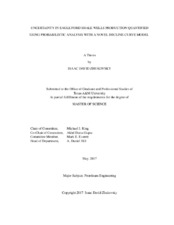| dc.description.abstract | This thesis proposes a Bayesian decline curve methodology, using Markov Chain Monte Carlo (MCMC) simulation and a novel empirical decline curve equation to better quantify uncertainty in estimated ultimate recovery (EUR) for oil shales. The methodology is calibrated using hindcasting of production data from an area of the Eagle Ford oil window. Hindcasting on an areal basis with 254 wells has demonstrated good results, with a coverage rate of true reserves of 78% for an 80% confidence interval (P90-P10), or 199 of the 254 wells tested. The novelty of the new model is in the implementation of the empirical decline curve equation for shale wells in Bayesian decline curve analysis with fast per well solution time on typical engineering computers
This method offers many benefits. Principally, the method quantitatively assesses uncertainty and avoids subjective estimates of uncertainty. The results the method generates are accurate for shale wells because the decline curve equation was empirically designed for such wells. Furthermore, it generates replicable results for given wells regardless of the forecasting engineer and offers a fast calculation time of 5-10 seconds per well in the data set.
The novel decline curve equation used in this methodology accommodates both early steep rate decline and later shallower decline with a smooth transition. Coupled with a Bayesian decline curve analysis process, the decline behavior of shale wells is assessed probabilistically with accuracy. The decline curve parameters are random variables with defined prior distributions. A MCMC simulation is performed to obtain the posterior distribution of well EURs. Wells in the sample set had >36 months of production with the first 12 months used as simulation input. The method is calibrated (hindcasted) on an areal basis by measuring the coverage rate of true reserves. The method, when applied to the Eagle Ford oil shale production data, demonstrates good convergence to stationary posterior distributions of the parameters. This is important because field development of the Eagle Ford and other shale plays is improved when uncertainty is accurately quantified. By quantifying uncertainty and moving away from deterministic decline curve analysis using equations designed for conventional reservoirs, a better understanding of shale well EUR and behavior throughout a play is obtained. | en |


